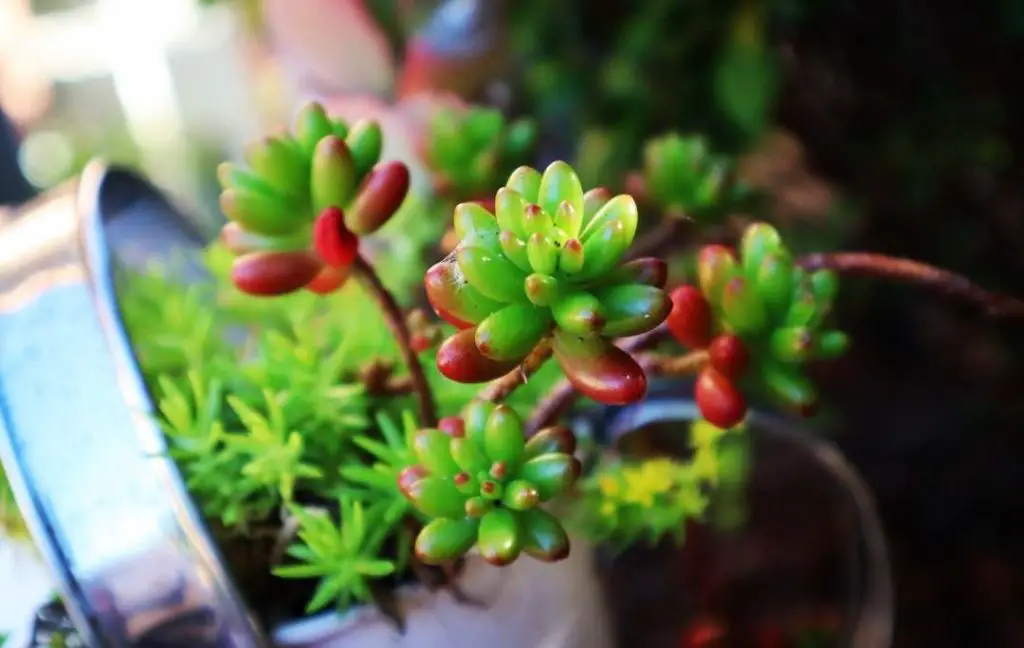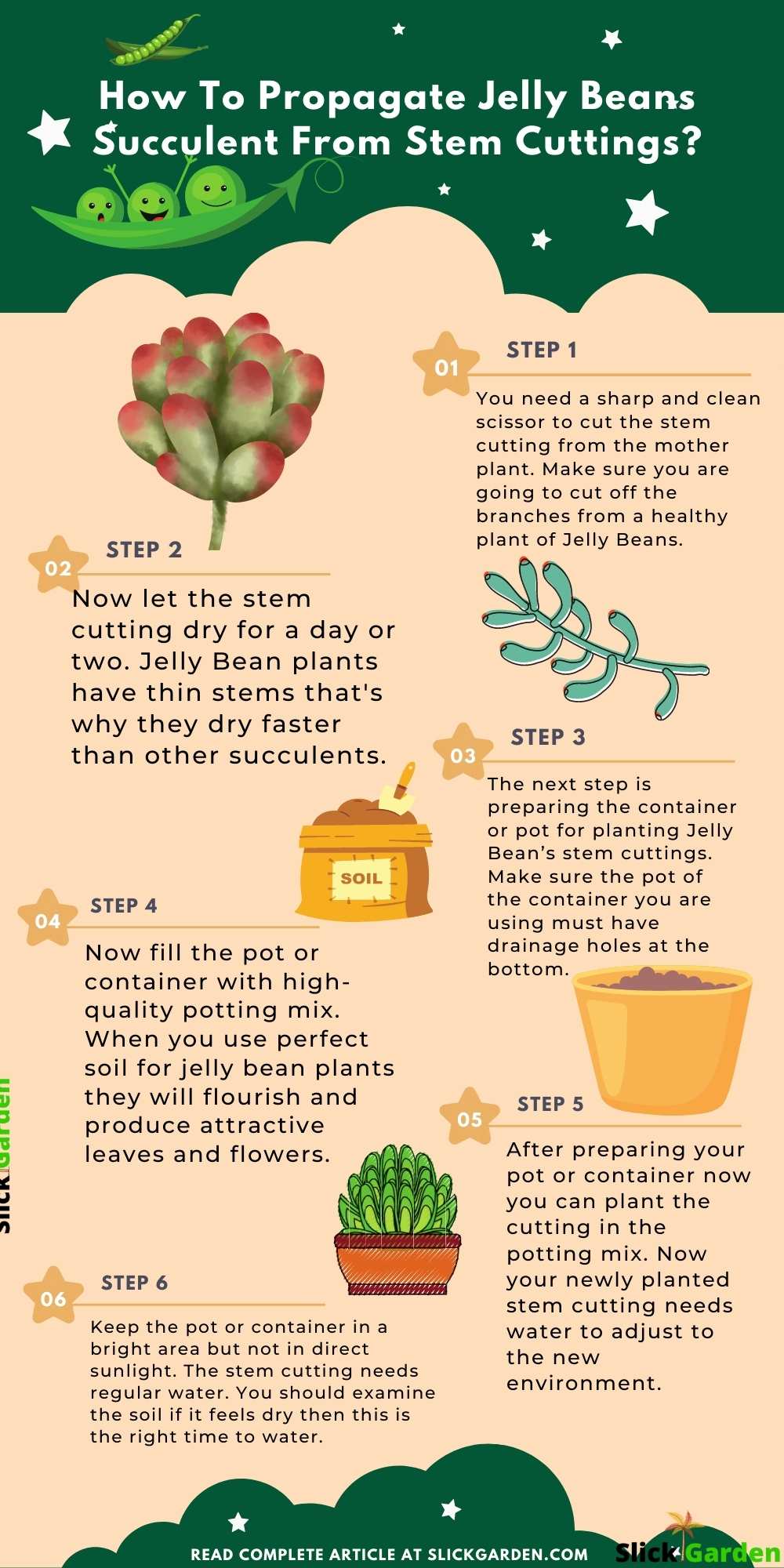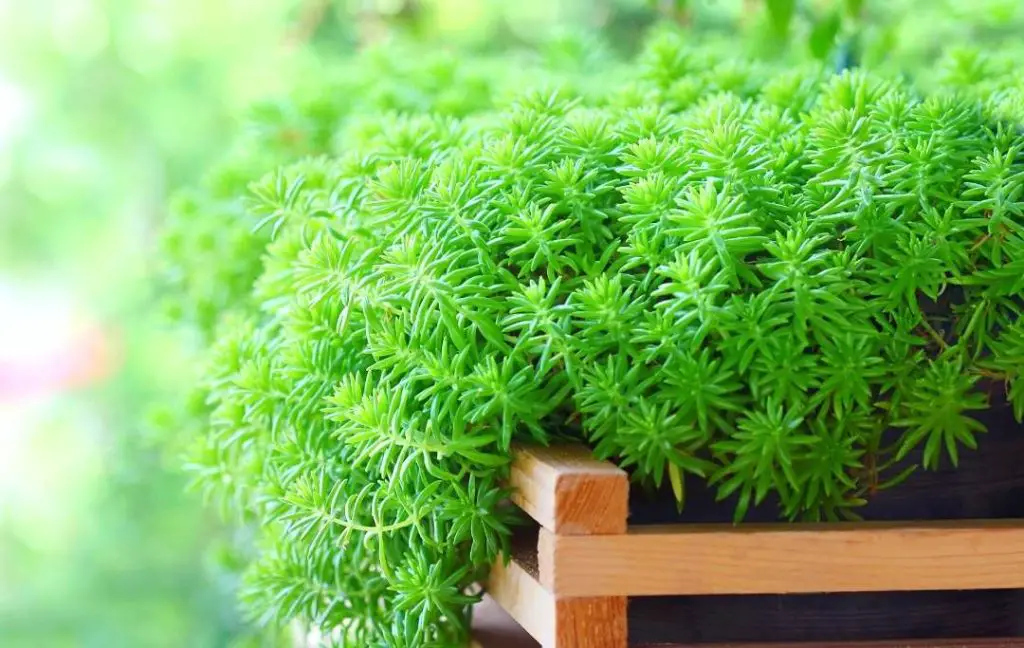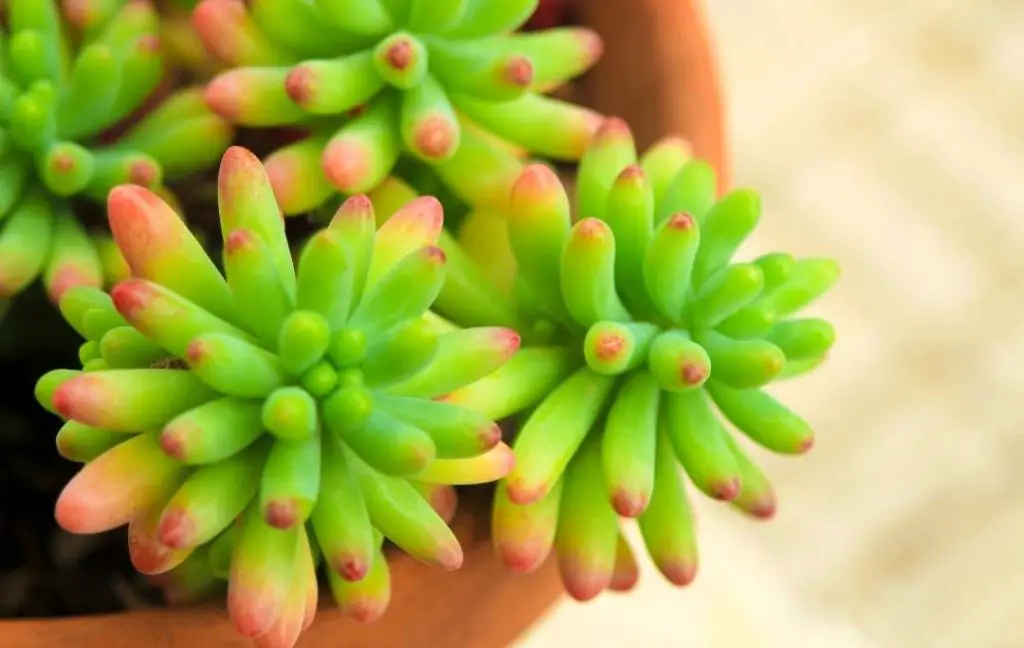The shape of the leaves of this plant is just like a jelly bean. That’s why it is called a jelly bean succulent plant. Leaves have a green shade and will turn red at the tips when this plant receives full sun exposure.
The star-shaped flowers of this plant have a bright yellow color. This plant produces flowers in Spring time. The other names for this plant are Beans, Pork, and Christmas Cheer.

This type of succulent plant needs little maintenance. You can effortlessly grow it in pots and containers. If you want the nice reddish color of this plant then you should choose a location where this plant receives maximum sunlight. The exciting thing about this plant is that you can easily propagate and multiply it.
How To Propagate Jelly Beans Succulent From Stem Cuttings?

It is a succulent plant so you can easily propagate the jelly bean from stem or leaf cuttings. Following are the simple steps of growing Jelly Beans from stem cuttings.
STEP 1
You need a sharp and clean scissor to cut the stem cutting from the mother plant. Make sure you are going to cut off the branches from a healthy plant of Jelly Beans.
The size of stem cutting should be 5cm long. Each stem cutting has a few pairs of leaves. You should cut the branches from the top of the plant. It is better to choose terms that have roots.
STEP 2
Now let the stem cutting dry for a day or two. Jelly Bean plants have thin stems that’s why they dry faster than other succulents.
STEP 3
The next step is preparing the container or pot for planting Jelly Bean’s stem cuttings. Make sure the pot of the container you are using must have drainage holes at the bottom.
Drainage is essential for the healthy growth of any plant. This helps to protect your plant from root rot and fungal diseases. If your pot or container doesn’t have drainage holes then you can make the holes with the help of a drill.
Now fill the pot or container with high-quality potting mix. When you use perfect soil for jelly bean plants they will flourish and produce attractive leaves and flowers.
The potting mix contains all the essential nutrients according to the needs of your plant. It contains perlite and peat moss for the healthy development of your plant.
STEP 4
After preparing your pot or container now you can plant the cutting in the potting mix. Now your newly planted stem cutting needs water to adjust to the new environment.
STEP 5
Keep the pot or container in a bright area but not in direct sunlight. The stem cutting needs regular water. You should examine the soil if it feels dry then this is the right time to water.
In a few weeks, you will see the tiny roots starting to establish in the soil. Now you can decrease the frequency of water and increase the sun exposure so the plant thrives well.
HOW TO CARE FOR JELLY BEAN PLANTS?

The botanical name of this plant is Sedum rubrotinctum. A succulent plant so the same growing techniques can be applied to growing this beautiful plant.
If you are a beginner then you should choose Jelly Bean plants for growing as it is easy to grow and tolerate an inhospitable environment. You should keep in mind jellybean plants are toxic, that’s why you should be careful.
Before touching this plant you should put your gloves on because it can give an uncomfortable skin rash. Children and pets should be kept away from Jellybean plants. Every plant needs your special care and attention. Under favorable conditions, your plants thrive well.
1- SIZE AND GROWTH
This is a fast-growing plant and can be reached at the height of 1 ft. This plant grows upward and at the end of the stem, the leaves are spaced closer. The size of the leaves is about ½ to 1 ½ inches. The leaves look like thumbs.
2- FLOWERING AND FRAGRANCE
Beautiful yellow flowers produce during spring under appropriate conditions. The fragrance of the flowers is not very discernible. The leaves of Jelly Bean plants will not change their color if they don’t receive enough sunlight.
3- WATERING
It is best to grow this plant outdoors where they also get enough sunlight and rainwater in spring or even summer months. You can water jelly bean plants every 10 days.
You can increase the frequency of water if the climate is hot. Due to the heat of the sun, the soil dries quickly that’s why your plants need more water.
It is better to check the soil of the plant with the help of your finger. If it feels dry it means you should water your plants. If you are living in a dry climate then jelly beans need more water on the contrary if you live in a humid area then your plant needs less water.
It means the frequency of the water for the jelly beans plant depends upon the climate in which you are living.
You should carefully examine the plant. If leaves start to shrivel and become very soft it means they need more water. You can also use a moisture meter to check the moisture level of the soil.
Another way of checking the moisture level is using a bbq skewer stick. If you see the skewer dry when you stick it in the soil of your pot or container then it is the right time to water your plants.
4- SOIL
Soil is the medium that provides all the essential nutrients to your plant. Make sure the soil you are using must be a rich inorganic material. You can use compost or manure to make the soil richer.
For drawing Jelly Beans you can also use a cactus mix with perlite. The ratio between cactus mix and perlite should be 1:1. The best soil helps in the development of your plant.
5- SUNLIGHT
For best color variation, you should place your pot or container in bright sunlight. You can also place this plant in partial shade but the leaves produced will not have the best colors.
The plants in shade produce more green leaves. Sunlight helps in changing the color of leaves. But if the weather is very hot then you should place the pot in a partial shade otherwise the leaves will burn.
In such conditions, shadier spots provide relief to your plant in intense heat. Jelly Bean succulent plants can tolerate frost but up to some extent. Freezing temperatures are not good for your plants so you can take your pot or container inside your home.
6- FERTILIZER
If you are using a high-quality potting mix for growing jelly beans in a pot or container then there is no need to apply fertilizer for 1 year. But if you examine your plant is not thriving as much then you can apply a small amount of fertilizer.
The best time to fertilize is from spring to early fall. You will get all the information and instructions on the packet of fertilizer that you are using. The tips and instructions are very helpful. You should follow them because more fertilizer can destroy your plant.
7- TEMPERATURE
Under favorable temperatures, your plants always thrive well. This plant likes cool temperatures and does its best when it is between 50 to 55 degrees Fahrenheit.
You can easily keep your pot or container outdoors in the cold months. Jelly Bean succulent plants can tolerate light overnight frost. But extreme frost is not good for this plant.
You should protect it from freezing temperatures and keep the plants indoors when the weather is favorable. You can place the plants outdoors. In case jelly bean plants are left outside then their leaves start stretching and lose their shape.
8- PESTS AND DISEASES
This plant is not susceptible to pests and diseases but in some circumstances, your Jelly Bean plant may be affected by some diseases.
For instance, overwatering can cause root rot and invite mushy brown spots on your favorite plant. If you want to prevent your plant from root rot then you should maintain the frequency of water.
Avoid overwatering and use well-drained soil to fill in your pot or container. Drainage also helps to protect your plant from many diseases. If you examine that the leaves of the plant are turning pale yellowish green then it is a symptom of plant deterioration.
The reason behind this change is due to a lack of light. In such a case, you should move your plant to a brighter location so it will get in enough light.
Some common pests such as scale and mealybugs can also affect your Jelly Bean plant. The insects and pests are a threat to your favorite plants.
If these tiny monsters attack your plant then it is better to use a cotton swab or rubbing alcohol. This will help to remove the visible pests. The other remedy is using insecticidal soap or neem oil to get rid of this problem.
How To Re-Pot Jelly Bean Plants?

When your plant grows then this is the time to re-pot it. But in the case of Jelly Bean plants, it has fragile leaves so you should be careful because their leaves can easily fall off.
Make sure when you are performing this task the soil of the pot must be dry because it will be easier for you to do. Your plant will come out easily when the soil is dry in the pot.
When you see your plant is sprawling out of the pot then it is better to re-pot it. When you are transplanting the jelly bean plant into another pot then you must be careful because it can be damaged.
With the help of a spade dug around the side of the plant to loosen the soil. This will take time, but you can easily pull the plant without facing any problems.
The other way of removing the plant from the pot is to break the pot. If your pot is made from plastic then you can cut it. But you should only do it in that case when you are afraid of damaging the plant.
The large planter needs more soil feeling after transplanting make sure you are using a combination of polite and cactus soil. Carefully transplant the plant into a larger planter.
You can also use some stem cutting from the same jelly bean plant. If some leaves are falling then you can plant them into the pot. Some leaves will grow and some will not but this is the part of gardening.
